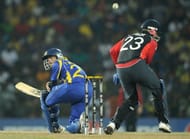
James Anderson of England has used his ability to swing the cherry the other way quite tactfully, in recent times. (Getty Images)
Sunil Gavaskar has always maintained that cricket is a batsman’s game. He argues that on a given day if a batsman scores a century and a bowler takes a five-for, then it would invariably be the willow holder who would dominate the next day’s newspaper headlines.
One may agree to disagree with the legendary opener’s viewpoint but there is little denying that over the years most of the major changes in rules have benefitted the batsmen; be it the introduction of covered pitch, the use of helmet, the shortening of boundaries or the imposed field restrictions in limited overs cricket.
Yet amidst all this, bowlers as a species have survived. And the cricketing universe can be thankful for that because it is the riveting battle between the bat and the ball that makes a game of cricket fascinating; in all three formats.
The key to their survival and indeed flourish in many cases has been their adaptability. Every time a rule has been tweaked in the ICC manual to favour the batsmen, bowlers have found a new way to pose different set of challenges to their batting counterparts. Listed below are some of the varied innovations that bowlers came up with to confront batsmen.
Reverse Swing:
The credit for introducing the world to the art of reverse swing goes to Imran Khan and his set of fast bowlers in the eighties, even though they were initially accused of illegal ball tampering for the same.
But over the years reverse swing was legitimised and considered as an ‘art’ of bowling. We all know how reverse swing can be produced by maintaining the shape and sheen of the ball on one side and letting the other side go through normal wear and tear.
What it did was to make fast bowlers relevant even in those dry surfaces, which were hitherto not considered conducive for them. It also doubled up the threat of the swing bowlers, who could trouble batsmen with conventional swing with the new ball and flummox them by reverse swinging the same cherry when it has lost its initial sheen.
What makes reverse swing more difficult to combat as compared to traditional in-swing for a right-handed batsman is the fact that the ball swings very late in the air, as a result of which it is very difficult for the batsman to gauge its exact line.
That is why according to veterans like Rahul Dravid, while facing reverse swing a batsman has to look to go forward (to combat the amount of swing) but at the same time he cannot commit himself too early as he is not sure of the exact amount of swing.
To complicate things further, expert exponents of reverse swing like Wasim Akram, Zaheer Khan and Freddie Flintoff frequently switched their bowling line form round the wicket to over the wicket without compromising on either their speed or accuracy.
At one point of time in late nineties and early noughties, non-strikers used to help the batsmen in strike to gauge which way the ball would reverse swing by indicating on which side of the bowler’s wrist is holding the shiny side of the ball. New Zealand deployed this strategy quite successfully against Javagal Srinath during their tour of India.
To counter that, bowlers these days hide the ball during their run up to the crease. Initially Zaheer Khan and now James Anderson have deployed this tactic quite successfully.
Slower deliveries:
As the limited overs component started increasing in the ICC cricket calendar, the usage of slower deliveries started gaining more prominence. In the shorter formats of the game, the 22 yards are normally designed to suit stroke play (true bounce, little lateral movement) and batsmen tend to hit through the line of the ball.
This is where foxing him with change of pace becomes critical. However it is not as easy as it sounds, for batsmen also look at the wrist of the bowler at the point of delivery to detect if he has tried any variation. There is a wide array of slower balls that bowlers have in their arsenal in modern day cricket.
First up, there is the back of the hand slower delivery. According to legends like Allan Donald, this is perhaps the most difficult variant of slower delivery to execute as there is maximum chance of ball slipping out of the hand. But if executed well, it is very difficult for batsmen to read it as it is delivered without significant bending of the wrist and also because the seam position of the ball remains identical to that of any normal length delivery.
The second variant, off-cutter, is perhaps the most widely used form of slower ball as it comparatively easier to control the same. In contrast the leg-cutter is not that popular among seam bowlers. Venkatesh Prasad used the leg-cutters to telling effect during his playing days.
The split finger slower ball was made popular by Dilhara Fernando. He had confessed that during a local tournament in the Emirates Island, the ball was slipping out of his hand because of the extreme sweat in his palms and fingers. Due credit has to be given to him for having spotted the opportunity that was presented through it and for having worked on it long enough to successfully execute it at international level.

Sri Lanka’s Tillakaratne Dilshan (L) plays a scoop shot over the head of England wicketkeeper Matt Prior (R) during the World Cup 2011 quarter-final at The R. Premadasa Stadium in Colombo on March 26, 2011. As batsmen have got more innovate, as have the bowlers with the slower bouncer and yorker. (Getty Images)
Slower Bouncer:
Till not so long ago a slower bouncer would have seemed like an oxymoron. Bouncers were meant to be short fast deliveries that were directed towards a batsman’s body. It was meant to intimate batsmen, push them to the back foot and get them out either in the slip cordon or at backward short leg.
While all of that remains true even today, bowlers have unearthed a cousin of the erstwhile bouncer, who may not share all the personalities of its older cousin, but proves to be just as effective.
Shaun Pollock is credited for having introduced this variant to the cricketing universe. In subcontinent pitches, a traditional bouncer at times was deemed less effective as the inherent slow nature of the track made it easier for batsmen to pull, hook or cut it for runs.
For a slower bouncer, the ball tends to grip the surface and therefore it becomes difficult for batsmen to predict the speed as well as the exact bounce on offer. As a result it is quite difficult to get them away.
During the death overs of a limited overs match a batsman can get away by swinging wildly at a bouncer and even a top edge can go for a boundary or six. But since there is not much pace on offer in a slower bouncer, a mistimed shot is more likely to fetch a wicket rather than going for runs.
Slower Yorker:
A fast straight/swinging yorker was a fast bowler’s best friend when he desperately needed wickets or dot balls during the business end of an innings. However, first Douglas Marillier and later Tillakaratne Dilshan came up with innovative ramp shots and scoop shots, which started becoming very productive, run scoring options.
Whenever a yorker would be attempted, they would get down on their knees and try to scoop the ball over the wicketkeeper’s head for four by using the pace on offer. That is where the slower yorker proved to be extremely useful.
While it continued to remain low and targeted at the stumps, the lack of pace meant that now the batsmen have to generate all the power. And doing that on a bent knee and that too for a delivery that is on yorker length can prove to be an onerous task in itself.
However a slower yorker’s value is not restricted to the limited overs arena. It can be just as useful in Test cricket as well, as Courtney Walsh exhibited against Graeme Thorpe in the nineties.

Sunil Narine of the West Indies delivers a ball during the first match of the Tri-Nation series at the Sabina Park stadium in Kingston on June 28, 2013. The spinner has bamboozled batsmen would over with remarkable consistency. (Getty Images)
Spinners bowling with New Ball:
If reverse swing has brought the pacers back into the game during the middle overs, spinners have given themselves a new lease of life by being just as effective with the new ball. There was a time when it was believed that spinners find it difficult to grip the ball properly when it is hard and shiny, and consequently they don’t get maximum purchase with the new cherry.
There are some opening batsmen, who are not very comfortable to use their feet against a spinner early on in their innings. A spinner can prove to be their nemesis in the opening overs. We have seen spinners exploiting this chink in the armour of explosive batsmen like David Warner and Chris Gayle.
Similarly in Tests, when the track offers slow turn and low bounce, spinners bowl with the new ball to extract maximum dividends. Graeme Swann turned the second Test against Sri Lanka in England’s favour by picking up two wickets with a fairly new (nine overs old) ball last year in Colombo.
Carrom spin:
It can be considered a third category of spin bowling after leg spin and off spin, as the middle finger and thumb flick oddly resembles a player flicking the striker in the indoor game of carrom.
While over use of the same can prove to be detrimental – as was the case with Ajanta Mendis – a judicious use of the same along with the traditional stock deliveries of a spinner can yield rich dividends. India’s R Ashwin and Sunil Narine of the West Indies are two torch bearers of carom spin at the moment.
Ken Ravizza, one of the world’s most renowned sports psychologists, had once stated, ‘Adversity is the fertilizer of growth’. In cricket, the bowlers have proved him right.
Follow IPL Auction 2025 Live Updates, News & Biddings at Sportskeeda. Get the fastest updates on Mega-Auction and cricket news
